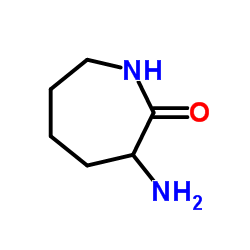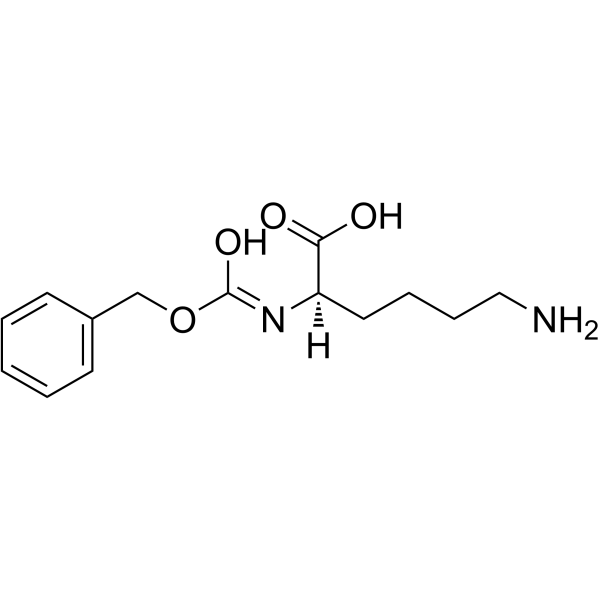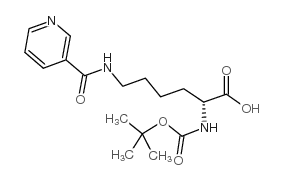D-Lysine monohydrochloride

D-Lysine monohydrochloride structure
|
Common Name | D-Lysine monohydrochloride | ||
|---|---|---|---|---|
| CAS Number | 7274-88-6 | Molecular Weight | 182.648 | |
| Density | N/A | Boiling Point | 311.5ºC at 760 mmHg | |
| Molecular Formula | C6H15ClN2O2 | Melting Point | 266ºC (dec.) | |
| MSDS | Chinese USA | Flash Point | 142.2ºC | |
Use of D-Lysine monohydrochlorideD-Lysine monohydrochloride is an Lysine stereoisomer which can be used as a component of surfactants[1]. |
| Name | D-lysine hydrochloride |
|---|---|
| Synonym | More Synonyms |
| Description | D-Lysine monohydrochloride is an Lysine stereoisomer which can be used as a component of surfactants[1]. |
|---|---|
| Related Catalog | |
| References |
| Boiling Point | 311.5ºC at 760 mmHg |
|---|---|
| Melting Point | 266ºC (dec.) |
| Molecular Formula | C6H15ClN2O2 |
| Molecular Weight | 182.648 |
| Flash Point | 142.2ºC |
| Exact Mass | 182.082199 |
| PSA | 89.34000 |
| LogP | 1.72990 |
CHEMICAL IDENTIFICATION
HEALTH HAZARD DATAACUTE TOXICITY DATA
|
| HS Code | 2922499990 |
|---|---|
| Summary | HS:2922499990 other amino-acids, other than those containing more than one kind of oxygen function, and their esters; salts thereof VAT:17.0% Tax rebate rate:9.0% Supervision conditions:AB(certificate of inspection for goods inward,certificate of inspection for goods outward) MFN tariff:6.5% General tariff:30.0% |
|
Enhancement of neuronal cell adhesion by covalent binding of poly-D-lysine.
J. Neurosci. Methods 202 , 38-44, (2011) We have prepared the poly-d-lysine (PDL) bound surfaces for neuron cell culture by covalent binding between the poly-d-Lysine and substrates and investigated neuronal cell adhesion properties and cell... |
|
|
Immobilization of peroxidase on SiO2 surfaces with the help of a dendronized polymer and the avidin-biotin system.
Macromol. Biosci. 11 , 1052-1067, (2011) Horseradish peroxidase (HRP) is immobilized in three easy steps on SiO(2) surfaces with the help of a polycationic second generation dendronized polymer (denpol) and the biotin-avidin system. This ste... |
|
|
A biofunctionalization scheme for neural interfaces using polydopamine polymer.
Biomaterials 32 , 6374-6380, (2011) Chemical surface modification of neuron-surface interfaces is essential for the development of biologically active and functional neural interfaces. Different types of surface modification schemes are... |
| D-Lys.HCl |
| H-D-Lys-OH hydrochloride |
| Lysine hydrochloride |
| L-Lysine HCl |
| hydrochloride,d-lysin |
| D-LYSINE HCL |
| D-Lysine-d4 HCL |
| HCl*H-D-Lys-OH |
| (S)-2,6-Diaminohexanoic acid monohydrochloride |
| D-Lysine hydrochloride |
| L-Lysine chlorhydrate |
| (2S)-2,6-diaminohexanoic acid hydrochloride |
| D-Lysinehydrochloride |
| (2S)-2,6-Diaminohexanoic acid monohydrochloride |
| L-Lysine, monohydrochloride |
| D-Lysine monohydroch |
| D-LYS HYDROCHLORIDE |
| MFCD00012920 |
| L-Lysine, hydrochloride (1:1) |
| D-lysine monohydrochloride |
| (S)-2,6-Diaminohexanoic acid hydrochloride |
| L-Lysine, hydrochloride |
| H-D-Lys-OH.HCl |
| D-Lysine hydrochloride (1:1) |
| D-Lysine, hydrochloride (1:1) |
| L-Lysine hydrochloride (1:1) |
| EINECS 230-691-6 |
 CAS#:34404-32-5
CAS#:34404-32-5 CAS#:31202-69-4
CAS#:31202-69-4 CAS#:28957-33-7
CAS#:28957-33-7 CAS#:70671-54-4
CAS#:70671-54-4![6-[[amino(nitramido)methylidene]amino]-2-[(2-methylpropan-2-yl)oxycarbonylamino]hexanoic acid structure](https://image.chemsrc.com/caspic/039/132718-70-8.png) CAS#:132718-70-8
CAS#:132718-70-8 CAS#:106719-44-2
CAS#:106719-44-2 CAS#:122546-52-5
CAS#:122546-52-5
